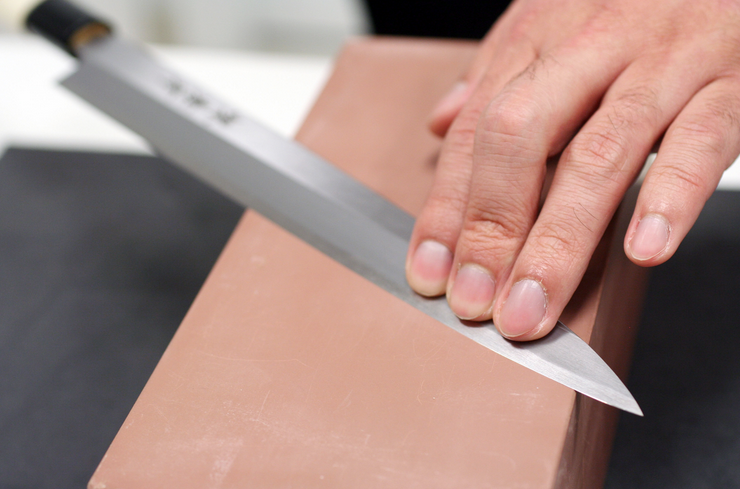WHAT SHOULD YOU KNOW ABOUT KNIFE SHARPENING?
WHAT SHOULD YOU KNOW ABOUT KNIFE SHARPENING?
When a knife is used, sooner or later it becomes dull. How quickly this happens depends on many factors. The most important of these are the hardness and quality of the steel, as well as the method of use and maintenance. You can read about the maintenance and use of knives here. This article focuses primarily on sharpening knives.
Is a sharp knife dangerous?
It is a fact that a sharp knife is safer than a dull one. If the basic techniques of working with a knife are familiar, the chef himself does not stick his fingers under the blade and does not do other stupid things, the chance of cutting a finger with a sharp knife is very small. When working with a sharp knife, it is necessary to apply significantly less force than with a blunt knife. Therefore, the knife is more likely to behave as the user wants with the cooperation of his brain and hand.
How often should a knife be sharpened?
The simple answer would be that a knife needs to be sharpened when it has become dull. Thus, the sharpening density depends, among other things, on the intensity of use. If a European chef's knife used in a professional kitchen may need to be sharpened even every day or more, the rule of thumb for Japanese knives could be that a professional chef sharpens the knife once a week and a home cook once a month. Of course, many other factors play a role, such as:
1. Blade material and quality. The higher the Rockwell number (HRC), the longer the knife stays sharp. The average HRC of Japanese knives is 58-63. European chef's knives average 52-56 HRC, which is why they are softer and dull more quickly.
2. What and how the knife is used: what foods are processed, what surface/cutting board is used, what are the user's knife handling skills, etc.
3. How the knife is maintained, washed, and stored.
"Tough and little" is definitely "healthier" for the knife than dulling the knife completely and then re-sharpening it. Frequent sharpening also uses significantly fewer steel layers to get the angle right again.
Is it difficult to sharpen a knife?
Although there are masters in Japan who have dedicated their lives to the art of knife sharpening, the basic skills of knife sharpening itself are not very difficult. Every serious knife enthusiast could learn the basics, sharpen his kitchen knives himself regularly, and thus keep them in working order for a long time. At the same time, it would not hurt to turn to a master from time to time (e.g. once a year) who will inspect the knives with a professional eye and sharpen them.
It is important to know that the traditional sharpening angle for European knives is 20 degrees, but for Japanese knives, it is usually 15 degrees. This may vary depending on the manufacturer, and the sharpening instructions that come with the knife should be followed. For example, the Samura knives in our selection have a recommended sharpening angle of 15-17 degrees.
Today, European manufacturers have also begun to produce thinner knives with a 15-degree sharpening angle, as consumers have signaled their preference for Japanese-style thin and sharp knives in recent years.
What tools do I need?
The best tool for sharpening Japanese knives at home is a whetstone, and a good selection is also available in our online store. Depending on the situation of the knife, a suitable water slide should be selected. Broadly speaking, water skis can be divided into three categories:
- Grit up to #1000: suitable for very dull and de-angled knives, as well as for restoring the shape of the blade in case of nicks and injuries (not recommended for beginners);
- Grit size #1000 - #3000: suitable for normal sharpening of knives that have been in normal use and have become dull;
- Grit above #3000: suitable for a sharpened knife with the latest so-called razor sharpness and final polishing.
Sharpening sticks and various types of mechanical and electric sharpeners are also used for sharpening. Before purchasing such a sharpening tool, always ask the seller which knives they are suitable for and how exactly to use them. Otherwise, your knife may become duller during "sharpening". Our selection also includes a hand sharpener with diamond discs that allow for different sharpening angles, which can be used to sharpen both Asian and European-style chef's knives.
Keeping a stable sharpening angle is probably the most difficult thing for a beginner knife sharpener. There is also a good tool for this - a sharpening stabilizer, which you can purchase here.
Where should I start?
There are many tutorials online that cover the basics of knife sharpening. See for example this:
https://www.youtube.com/watch?v=fks7RH-SeTA&t=30s
We recommend that you start practicing with some less expensive knives, as improper handling can significantly damage the knife. Once the skill is acquired, sharpening a knife at home should not take more than 15 minutes. Happy sharpening!
Author of the article: Margus, Tallinn Cutlery

